On the train yesterday, I was sitting opposite this guy who looked vaguely familiar. But it was only when he spoke on his mobile that I recognized him - it was the remarkably deep northern accent - he's been called Yorkshire's answer to Barry White - that gave him away. Chris Finch off The Office. Finchy - what a character.
jamie goode's wine blog
mainly wine...
Friday, March 31, 2006
 It seemed like relatively easy money. £200 for what would likely be an hour's work. The job? To list my five favourite wines sealed with cork, together with a short description of each, a brief biog and a picture. This was for a promotional booklet for APCOR (association of Portuguese cork producers), coordinated by the media company who are running the current Mourinho-fronted advertising campaign for cork.
It seemed like relatively easy money. £200 for what would likely be an hour's work. The job? To list my five favourite wines sealed with cork, together with a short description of each, a brief biog and a picture. This was for a promotional booklet for APCOR (association of Portuguese cork producers), coordinated by the media company who are running the current Mourinho-fronted advertising campaign for cork.I tend not to turn work down, but this time I said no. I'm writing a book on closures, and I can't be seen to be supporting a particular closure type: by doing this, I'd effectively be endorsing APCOR's campaign. I can't, because I don't beleive in it. It's not focusing on closure performance, and at the last press conference they were still citing the highly dubious taint rate that came from the flawed Wine and Spirit Association Musty Taint Survey. Besides, the wines I would have chosen aren't great wines because of the closure type; they'd be just as good sealed with alternative closures that offer the same oxygen transmission rate. You have to draw the line somewhere. It will be interesting to see which journalists decide to participate in this exercise.
Thursday, March 30, 2006
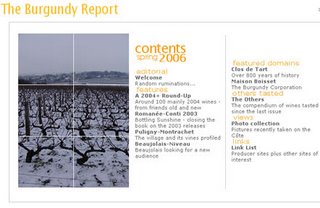 Time to plug Bill Nanson's Burgundy Report since his spring edition has just been published. It's a superb resource. It would be nice if it were available in pdf form so we could print it out and read it in the bath. Or in the garden. Or other places where laptops aren't much good.
Time to plug Bill Nanson's Burgundy Report since his spring edition has just been published. It's a superb resource. It would be nice if it were available in pdf form so we could print it out and read it in the bath. Or in the garden. Or other places where laptops aren't much good.Special kudos to Bill for the wonderful design and photography on his site. The pictures really bring the region to life.
Wednesday, March 29, 2006
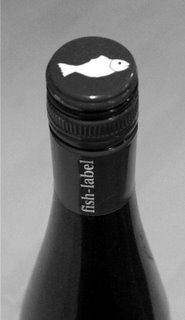 Bad news for winemakers in Catalonia, Spain. It seems that they won't be able to get the DO for their wines if they use alternative closures such as screwcaps and synthetic corks.
Bad news for winemakers in Catalonia, Spain. It seems that they won't be able to get the DO for their wines if they use alternative closures such as screwcaps and synthetic corks.Two news pieces (here and here) report on the decision by the Catalan Minister of Agriculture and INCAVI (the Catalan institute of vines and wines) to outlaw the use of non-cork closures in the region, which includes some of Spain's key vineyards.
But get a load of this: "This Spanish law is yet another endorsement for the cork closure," says Elisa Pedro, director of communication for APCOR, the consortium of Portuguese cork producers. "Spanish law makers and wine producers are responding to what wine drinkers the world over have been telling us for a long time - cork is a sign of quality for wine." Am I living in a parallel universe? How can this not be a huge step backwards for the wine industry? It's certainly a business opportunity for Gregor and the guys at ProCork.
Really enjoying the Emperor of scent, a book I mentioned here a few days ago. Just found a good interview with the author which gives a fair idea of what the book is about. For the more technically minded, the subject, Luca Turin, has published a review of rational odorant design on his company's website. Olfaction, the science of smell, is at the heart of wine tasting, but it's a subject not often discussed.
Tuesday, March 28, 2006
Eric Asimov of the New York Times has made an interesting post in his blog following up his piece last week on Uber critic Robert Parker.
RP is a bit of a focus for me at the moment, since I'm reading Elin McCoy's biography of the big man (linked in a post below). It's a good book, primarily because the subject matter is so absorbing. The big question is, of course, is the world of fine wine better now than it was pre-RP? And the supplementary question is, how much of this change, for better or worse, is down to his influence?
It would take a book to give a comprehensive answer. I suspect that looking back on the current era in some 20 years time, we will, to employ an overused quote from Dickens, feel that this was the best of times, it was the worst of times; it was the age of wisdom, it was the age of foolishness. Wine is better than it has ever been. But, at the same time, I think fine wine is imperiled.
Monday, March 27, 2006
A busy weekend of tasting through the mixed cases that have arrived from various retailers for a forthcoming double page spread in the Sunday Express. Too soon to draw any firm conclusions, but the impression I have so far is not universally positive. One retailer sent me a 'medal winning whites' case where three of the wines were clearly past their best. One was a 2002 white sealed with a synthetic cork, and entering its decline phase rapidly. A warehouse-clearing exercise underway? I almost fell asleep tasting through another case: utterly boring wines with little merit at all.
This raises the issue of drink-by dates for wines. Most commercial whites are made in a fresh style and are at their best as young as you can get them.
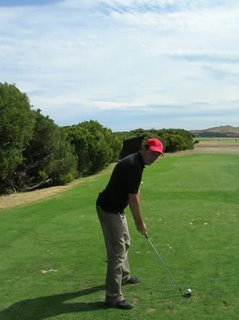 Managed to get out onto the golf course with my oldest son - a gentle little pitch and put, after hitting a basket of balls on the range. He's coming on well. Getting the boys interested is my best chance of playing golf on a regular basis. It's a sad sport, I know, but I do enjoy it. I made a tiny tweak to my swing (dropping the left shoulder a bit more at set-up) and suddenly I'm hitting much better. Even with my driver. How exciting. Pictured is me teeing up for my recent round at the lovely Flinders course on the Mornington Peninsula.
Managed to get out onto the golf course with my oldest son - a gentle little pitch and put, after hitting a basket of balls on the range. He's coming on well. Getting the boys interested is my best chance of playing golf on a regular basis. It's a sad sport, I know, but I do enjoy it. I made a tiny tweak to my swing (dropping the left shoulder a bit more at set-up) and suddenly I'm hitting much better. Even with my driver. How exciting. Pictured is me teeing up for my recent round at the lovely Flinders course on the Mornington Peninsula.
Friday, March 24, 2006
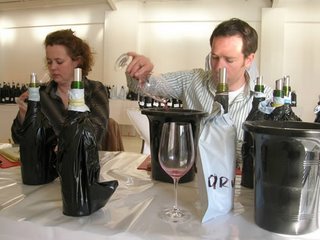 The last two days I've spent judging the top 100 Vin de Pays competition. As part of a 16-strong team of elite tasters (of whom I was the junior and least of all), we whittled 2000 wines down to just 100, with 12 trophy winners. We worked in teams of three, and it was actually pretty good fun. On Thursday I was with Sam Harrop MW (consultant) and Jo Aherne (M&S) (pictured), and today I was with Chris Hardy (Majestic) and Anthony Rose (The Independent).
The last two days I've spent judging the top 100 Vin de Pays competition. As part of a 16-strong team of elite tasters (of whom I was the junior and least of all), we whittled 2000 wines down to just 100, with 12 trophy winners. We worked in teams of three, and it was actually pretty good fun. On Thursday I was with Sam Harrop MW (consultant) and Jo Aherne (M&S) (pictured), and today I was with Chris Hardy (Majestic) and Anthony Rose (The Independent).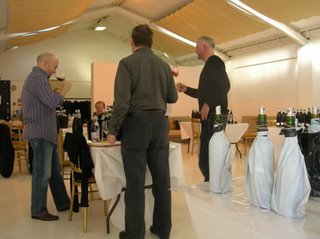 It's useful to taste with experienced tasters, and then share perceptions. It's a learning experience and you can't have too many of those. Overall thoughts? Some really nice wines, but Merlot (especially) and Cabernet in the Languedoc are a bit of a waste of time. Ditto for Sauvignon Blanc and Chardonnay, which tend to make very boring wines. The organization of the tasting, by Sopexa, was great, and Tim Atkin chaired the whole event with good humour and professionalism.
It's useful to taste with experienced tasters, and then share perceptions. It's a learning experience and you can't have too many of those. Overall thoughts? Some really nice wines, but Merlot (especially) and Cabernet in the Languedoc are a bit of a waste of time. Ditto for Sauvignon Blanc and Chardonnay, which tend to make very boring wines. The organization of the tasting, by Sopexa, was great, and Tim Atkin chaired the whole event with good humour and professionalism.
Thursday, March 23, 2006
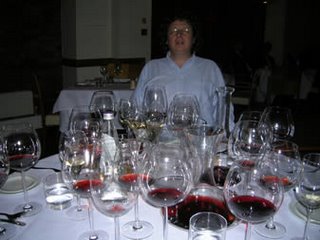 Last night's dinner with Dirk Niepoort (Portugal's leading winemaker?), Neil Beckett (editor of World of Fine Wine) and Zubair Mohamed (who owns one of the UK's top wine shops, Raeburn in Edinburgh), proved to be very serious indeed. It was tremendous fun, and the wines were quite brilliant. Here are my notes.
Last night's dinner with Dirk Niepoort (Portugal's leading winemaker?), Neil Beckett (editor of World of Fine Wine) and Zubair Mohamed (who owns one of the UK's top wine shops, Raeburn in Edinburgh), proved to be very serious indeed. It was tremendous fun, and the wines were quite brilliant. Here are my notes.Raymond Boulard Petraea NV Champagne
Quite a rich, perfumed nose which is fruity and nutty. Complex with some spiciness. The palate is quite rich and fruity with some sweetness to the fruit. Quite developed with nice balance. Very tasty. Very good/excellent 91
Krug 1995 Champagne
A precise, focused wine of real intensity. The nose is tight with nutty, lemony and subtly meaty notes. The palate is rich, savoury and fine with high acid. Lots of concentration and some elegance. This is a complex wine that needs some time, and in time I reckon will become profound. Expect the score to increase. Very good/excellent 94/100
Raveneau Chablis 1er Cru Butteaux 1995
Very serious toasty, complex, nutty, minerally nose with great depth. The palate is rich, pure and minerally with good acid. Complex and concentrated: a brilliant wine. Excellent 95/100
Louis Remy Chambertin Grand Cru 1964 Burgundy
Earthy, spicy and perfumed with a tarry, aromatic, minerally complexity. Powerful, structured palate showing lots of evolution. Delicious and quite elegant. Very good/excellent 92/100
Giacamo Coterno Barolo Cascina Francia 1994 Piedmont
Full, perfumed spicy nose with an earthy character under the red fruits. On the palate it’s tight and very structured with some savouriness. A youthful, complex wine that’s tannic and quite savoury. Serious stuff. Very good/excellent 94/100
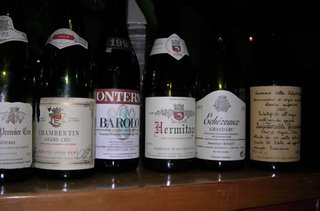 Chave Hermitage 1998
Chave Hermitage 1998Sweet ripe dark fruits on the nose – very elegant and rich. The palate shows a nice spicy earthiness, together with good tannins, and some minerality. It’s spicy and structured under the elegant, open fruit. Brilliantly pure and elegant with great finesse. Excellent 96/100
Emmanueal Rouget Echezeaux 1997
Dark, pure, ripe sweet red and black fruits on the nose. The palate is silky and elegant with lovely subtle spicy structure, cherry and berry-ish fruit. Sweet and quite alcoholic but showing lovely elegance. Very good/excellent 94/100
Quintarelli Amarone Riserva 1985
Very sweet, aromatic, bold and complex. Ripe sweet red fruits with some spice. The palate is sweet and rich with lovely spicy, bold red fruits and grippy structure. A remarkable wine with lots of impact. Very good/excellent 93/100
Wednesday, March 22, 2006
 By coincidence the two books I'm currently reading are both about emperors. The first is The emperor of scent, which was given to me by James Halliday on my recent Aussie trip. We got chatting and he thought I'd enjoy it. He's right - it's a good read.
By coincidence the two books I'm currently reading are both about emperors. The first is The emperor of scent, which was given to me by James Halliday on my recent Aussie trip. We got chatting and he thought I'd enjoy it. He's right - it's a good read. The second is a review copy of Elin McCoy's The emperor of wine, subtitled The remarkable story of the rise and reign of Robert Parker. This is out next month in the UK. I'll let you know how I get on with it and what I think.
The second is a review copy of Elin McCoy's The emperor of wine, subtitled The remarkable story of the rise and reign of Robert Parker. This is out next month in the UK. I'll let you know how I get on with it and what I think.
A lunchtime browse of the shelves at a local Oddbins (www.oddbins.com) left me modestly encouraged. This UK-based high street wine chain was at the forefront of the wine revolution that occurred during the 1990s. Over recent years, however, the murmuring among geeks has been that Oddbins' range has lost its way, with fewer interesting wines and higher prices. Now this chain seems to be showing signs of recovery: yes, prices are a little higher than the likes of Waitrose and Majestic, but there are some really interesting wines on the shelves. I found myself buying a Marcel Deiss Pinot Blanc 2002 for £8 and a Loire Chenin advertising itself as a wine for sushi for £7 (strangely, this lacked any information on vintage, appellation and producer - I'm guessing it's a 2004 Anjou Blanc). I was tempted by Ben Glaetzer's Heartland Petit Verdot 2004, but I really don't need to be buying wines seeing how awash with samples I am at the moment. The Sunday Express want me to do a double page spread on wine by mail order/web, focusing on reviewing 8 mixed cases, so that will be quite a sample session opening almost 100 wines at once.
Tonight I'm off to dinner with Dirk Niepoort, Neil Beckett and Zubair Mohamed of Raeburn Fine Wines. Should be fun.
Tuesday, March 21, 2006
 Tesco, the UK's largest supermarket, sells a staggering amount of wine. I don't have the exact figures to hand, but it's in the order of one-third of all off-sales in the UK. Today was their press tasting, which was held at the imposing venue of London's County Hall. On show were some 76 wines from the regular range (totalling 750 lines), plus the debut showing of the new premium range. These 50 wines, ranging in price from £10-£100, will be stocked in 200 stores in 'bespoke fixtures'. It's a welcome development.
Tesco, the UK's largest supermarket, sells a staggering amount of wine. I don't have the exact figures to hand, but it's in the order of one-third of all off-sales in the UK. Today was their press tasting, which was held at the imposing venue of London's County Hall. On show were some 76 wines from the regular range (totalling 750 lines), plus the debut showing of the new premium range. These 50 wines, ranging in price from £10-£100, will be stocked in 200 stores in 'bespoke fixtures'. It's a welcome development.Some nice wines, but I'll just report on a few. The Taittinger Prestige Rose (£32.99) impressed me with its complexity and finesse. Defaix-Raveneau 1999 Chablis 1er Cru Cote de Lechet (£16.99) was deliciously savoury and just a little funky: a reall nice wine. The Trimbach Riesling Cuvee Frederic Emile 2000 Alsace (£23.99) was a real star: only 2.9 g/litre residual sugar but the complex, expressive fruit had a sweet quality to it. Delicious. Perhaps my favourite wine of the tasting was also from Alsace: Zind Humbrecht's Gewurztraminer Herrenweg 2000 (£16.99). It's hugely rich and medium sweet with lovely complex melon and lychee flavours. Really nicely balanced. Two vintages of Penfolds Grange (£99.99) were on tasting: the 1997 and 1999. Neither are top-flight Grange vintages. The 1997 shows
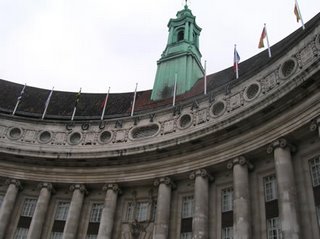 menthol-edged, spicy, almost medicinal fruit with some warmth, and the 1999 punches hard with intense spicy red and black fruits, together with some tarry, menthol-edged oak imprint.
menthol-edged, spicy, almost medicinal fruit with some warmth, and the 1999 punches hard with intense spicy red and black fruits, together with some tarry, menthol-edged oak imprint.County Hall is an interesting venue. Beautifully situated on the south bank of the Thames, opposite Westminster, its labyrinthine insides took quite some negotiating to locate the room Tesco had hired. Away from the bits frequented by the public (it houses an aquarium and a hotel), it has a rather sleepy, disused feel to it.
Monday, March 20, 2006
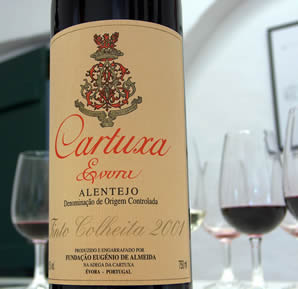 It's funny the difference that one bottle of wine can make. For many, all it took was just one special bottle to launch them on the journey of wine geekdom. One day they were drinking wine as a commodity; the next they realised that wine could be special, moving, life-enhancing. I hear this sort of story all the time from people.
It's funny the difference that one bottle of wine can make. For many, all it took was just one special bottle to launch them on the journey of wine geekdom. One day they were drinking wine as a commodity; the next they realised that wine could be special, moving, life-enhancing. I hear this sort of story all the time from people.I can trace my love for Portuguese wines back to an epiphanal experience with a bottle bought for me some years ago by my wife, Fiona. It was the 1995 Cartuxa, from a winery in the Alentejo which I profiled today on the main part of my site. This was back in February 1999, and Fiona had been shopping in Bentalls in Kingston, which at the time had a fantastic Portuguese selection. Without any knowledge of what she was buying, Fiona spent £9.50 on a treat for me - this was higher than our usual spend. The wine enchanted me. It's strange how just one bottle can make such a difference.
Sunday, March 19, 2006
 Met with a Professor of Philosophy on Friday, Ole Martin Skilleås (pictured), from Bergen in Norway. Ole Martin's speciality is aesthetics, and currently he is writing a book on the philosophy of wine appreciation. The philosophy community seems to be quite interested in wine: I know of two other books on the subject at various stages in the production process. During lunch, at Regent's Park Cafe, I learned a good deal, including a new phrase, 'selling elastic by the metre'. It's new to the English language, direct from Norway: don't you just love it?
Met with a Professor of Philosophy on Friday, Ole Martin Skilleås (pictured), from Bergen in Norway. Ole Martin's speciality is aesthetics, and currently he is writing a book on the philosophy of wine appreciation. The philosophy community seems to be quite interested in wine: I know of two other books on the subject at various stages in the production process. During lunch, at Regent's Park Cafe, I learned a good deal, including a new phrase, 'selling elastic by the metre'. It's new to the English language, direct from Norway: don't you just love it?As usual, quite a few wines sampled this weekend, but one I want to comment on is a very ambitious Spanish wine from the Toro appellation. Regular readers here will know of my enthusiasm for the Cano Toro 2004 from Vina Bajoz, which I described as the best sub-£3 wine ever. This example of Toro, the Campo Eliseo 2003, is more than ten times the price (rrp £34.95), and is of noble birth - it's a team effort from Jacques and Francois Lurton, and Michel and Dany Rolland.
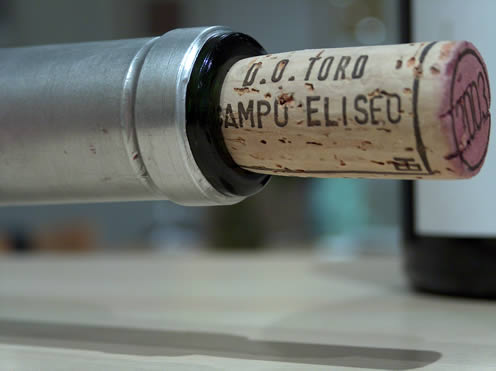 I couldn't make my mind up about this wine. Inital impressions were that they'd picked very late (alcohol is a stonking 15.5%) and then added some structure by a bit of micro-oxygenation (perhaps?) together with classy oak use.
I couldn't make my mind up about this wine. Inital impressions were that they'd picked very late (alcohol is a stonking 15.5%) and then added some structure by a bit of micro-oxygenation (perhaps?) together with classy oak use.There's certainly a good deal of elegance here, and the oak is superbly integrated with the lush, almost liqueur-like fruit (red, not black). But it's a bit like a night club bouncer who reads poetry: there's sophistication, but it's somewhat incongruous with the essential nature of the wine. I like it, but came away feeling that it lacked real personality, and certainly didn't deliver what you'd expect from a £35 wine. Yet while I wanted to dismiss it as an overpriced international-styled concotion lacking soul, there was enough there to keep me from condemning it. It just might be a serious effort, but right now I can't tell.
Friday, March 17, 2006
Non-wine related, I thought I'd draw readers' attention to an entry from another blog, 43 folders, here, about managing emails. I quote:
It's a really useful site - there's another post I just read on flow. This is some information I may just act on.This kind of “always on” approach to email (taken to extremes with those poor bastards praying into their Blackberries all day) has become a way of life for many of us. The idea of not checking email for 30 minutes can cause hives, twitching, and minor bodily leakage. “What if I ‘miss’ something?” And in some jobs, sure, it’s a requirement; you actually are so integral to your company’s existence that your electronic absence for 10 contiguous minutes might cause NASDAQ de-listing, financial ruin, and the immediate firing of that really cute girl from Finance. Fine. Understood. Skip the rest of this, and get back to your impossibly important job, Mr. Trump
"Accept that your workload exceeds your resources — that you are the first and last filter for what deserves your time — and you’ll already be better off than you were even two minutes ago."
Thursday, March 16, 2006
 Two more reviews of my book to report on. First, a nice one of the US edition in the San Francisco Chronicle, which you can find here. Then a strangely ambivalent one in Harpers, who mischievously got David Bird to do the job. Now, I don't know how you'd feel if you were in my shoes. I'd previously reviewed Bird's book on Understanding wine technology for Harpers, and as an honest reviewer, while I was complimentary about the content, I panned the home-spun design and general low budget appearance of the book. Bird was upset and wrote in to Harpers explaining this. Yet Harpers asked him to review my book. I feel like I have a good relationship with Harpers: they were the first to commission my work, and in recognition of this I have written for them regularly and haven't contributed to any of their competing trade titles. This is my first book, and it's important it gets a good reception with the trade - I've been delighted that so far all reviews have been extremely complimentary. Bird's isn't: he has a string of petty quibbles, yet he tries to balance these with positives, and as a result the whole review has a really odd feel to it. It's the nice reviewer/nasty reviewer routine. It's a bit of fun, perhaps, but I'm not sure it's the best tactic for winning friends and influencing people. I'm a forgiving sort of guy, though, but I hope that it doesn't mean that when I next come to review a book I have to modify my content for fear of the tables reversing: I still thing it's best to say what you think.
Two more reviews of my book to report on. First, a nice one of the US edition in the San Francisco Chronicle, which you can find here. Then a strangely ambivalent one in Harpers, who mischievously got David Bird to do the job. Now, I don't know how you'd feel if you were in my shoes. I'd previously reviewed Bird's book on Understanding wine technology for Harpers, and as an honest reviewer, while I was complimentary about the content, I panned the home-spun design and general low budget appearance of the book. Bird was upset and wrote in to Harpers explaining this. Yet Harpers asked him to review my book. I feel like I have a good relationship with Harpers: they were the first to commission my work, and in recognition of this I have written for them regularly and haven't contributed to any of their competing trade titles. This is my first book, and it's important it gets a good reception with the trade - I've been delighted that so far all reviews have been extremely complimentary. Bird's isn't: he has a string of petty quibbles, yet he tries to balance these with positives, and as a result the whole review has a really odd feel to it. It's the nice reviewer/nasty reviewer routine. It's a bit of fun, perhaps, but I'm not sure it's the best tactic for winning friends and influencing people. I'm a forgiving sort of guy, though, but I hope that it doesn't mean that when I next come to review a book I have to modify my content for fear of the tables reversing: I still thing it's best to say what you think.
Took the Jubilee Line and Docklands Light Railway out to Crossharbour this morning, for a by-line photoshoot for the Sunday Express. It was bitingly cold, and Canary Wharf and environs had a bleak, almost deserted feel.
The studio was on the ground floor of the Northern and Shell Tower, and after some attention from the stylist (guys, don't you just love wearing make-up?) I was photographed many times. I had to bring a light and dark shirt, and everyone laughed when I changed into my white shirt - let's just say that my standard of ironing isn't high, and I was in a rush this morning. We identified the photographer as the best ironer among us, so he straightened things out.
The pictures were surprisingly good. I'll post one here when I get the chance, and when blogger's image upload problem is fixed (it hasn't been working properly for three days, which means the only other option is the more time consuming one of loading the image to my site and then editing the post in html).
Wednesday, March 15, 2006
Back in the normal routine again. I feel like I lost a day or two somewhere, and I was horrified to find out that the UK is still in the grip of winter, without even the slightest sign of spring.
One spot of good news on my return is that I will no longer have to kill myself to reach a June deadline for the next book (a general wine title, for MQP), which I was about to sign the contract for. I keep deadlines and so this would have taken a major chunk of my waking hours, especially seeing as my closures book needs to be a priority. Fortunately, the deadline has shifted to December.
One of the issues of Harpers waiting for me on my doorstep had an article by Jack Hibberd about the Bajoz Cano, publicized first here. I quote:
"For a wine produced by a co-op in a region little known in the UK outside of the trade and wine enthusiasts, it is quite a result: Viña Bajoz’s Caño brand, from the DO of Toro in Castilla y León, sold 13,000 six-bottle cases in Tesco during a single week last month.
"The main reason for this sales spike was, as always, a hard-and-fast discount that saw the retail price fall from £4.49 to £2.99 for the blend of Garnacha and Tinta de Toro (the local version of Tempranillo). A general Tesco promotion that gave a further 20% discount on any six-bottle cases coincided with the Caño promotion, meaning bulk buyers could have a bottle for as little as £2.38.
"Price, however, doesn’t tell the whole story. Caño’s success is also about PR. As Ben Smith, who runs Bibendum’s PR department, explains: ‘I sent out a couple of bottles to
the major newspaper journalists, and the response was fantastic. It all went a bit silly really. I didn’t expect the response we got.’
"These responses include Jane MacQuitty of the The Times urging her readers to ‘buy, buy, buy’, Jamie Goode at the Express declaring the wine was probably ‘the best sub-£3 I’ve ever tasted’, and Victoria Moore over at The Guardian advising her readers to fill their boots."
Monday, March 13, 2006
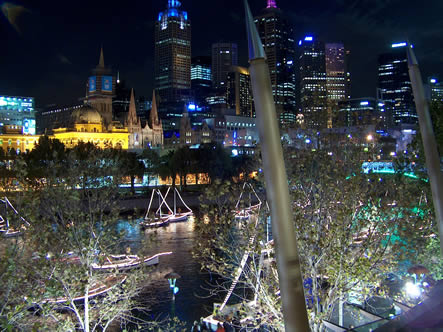
As I have probably mentioned before here, Singapore airport is one of the easiest in the world to hang out in. Brilliant connectivity (free internet browsing and cheap wifi) is the big plus - another benefit is that it never seems crowded. And the toilets are spotless. So as I sit here waiting for another plane, here's a nice picture of Melbourne at night, taken while I was dining on the banks of the Yarra earlier this evening (or is that now yesterday evening? I'm not sure).
Melbourne was gearing up for the Commonwealth Games, and tonight was the dress rehearsal for the opening ceremony at the MCG. It was being taken quite seriously: apparently, media who leaked the content were being threatened with a A$250 K fine. Ouch. I don't think I'm revealing anything by saying that the lit-up boats in my shot were part of the event. Further along the river, leading up to the MCG itself, were a series of big fishes, each one different and representing a commonwealth country. I couldn't tell which fish represented GB: it looked something like a carp, but it could have been a sort of compressed trout.
We drank a Giant Steps Pinot Noir 2004 with dinner: a supple, fruity Yarra Valley Pinot from Phil Sexton, who I visited earlier in the week. He's also the man behind the excellent Little Creatures Pale Ale, which we drank as a warm up. The previous night at the Stokehouse in St Kilda I was delighted to find two 'new Barossa' wines on the list - the juicy, succulent, almost profound Joshua 2004 from Kym Teusner (unoaked Grenache), and the stunning Spinifex Indigene 2003 (a Syrah/Mourvedre blend). Both were very good value at around the $50 mark, on a seriously good wine list.
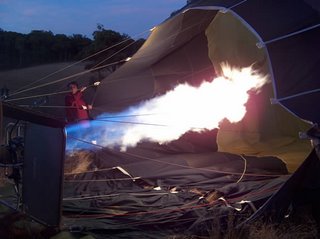 Sorry for the radio silence. Been busy in the Yarra, and lately in Melbourne. The Yarra was fantastic - thanks to my generous hosts, Tony and Michelle Jordan (Domaine Chandon) I got to meet all the right people. Everyone was generous with their time, despite the fact that vintage was already in full swing, three weeks earlier than normal. The Yarra rocks. Lots of very good wines: it's a high quality destination for Chardonnay, Pinot and Shiraz Viognier (the new rage here). Cabernet also performs.
Sorry for the radio silence. Been busy in the Yarra, and lately in Melbourne. The Yarra was fantastic - thanks to my generous hosts, Tony and Michelle Jordan (Domaine Chandon) I got to meet all the right people. Everyone was generous with their time, despite the fact that vintage was already in full swing, three weeks earlier than normal. The Yarra rocks. Lots of very good wines: it's a high quality destination for Chardonnay, Pinot and Shiraz Viognier (the new rage here). Cabernet also performs.On Sunday morning I also had a bit of a treat: a balloon ride over the region. We started out at dawn and spent an exhilarating hour drifting a couple of thousand feet up over the Yarra, before touching down gently in a field behind Yering Station winery. Here are a couple of pictures taken before and during the flight.
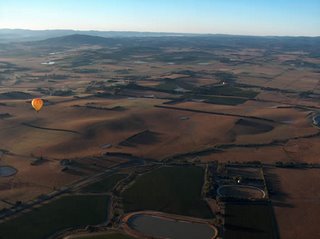 After landing it was off to Melbourne, to hook up with Gregor Christie of ProCork. We spent the afternoon in the Mornington Peninsula, where after one winery visit we abandoned our plan to go to a Pinot tasting when we found that the beautiful Flinders Golf Course had a spare slot. Today we did a bit more work, heading off to the Pyrenees region. I'm now in Melbourne departure lounge waiting for my flight, the 0050 to Singapore.
After landing it was off to Melbourne, to hook up with Gregor Christie of ProCork. We spent the afternoon in the Mornington Peninsula, where after one winery visit we abandoned our plan to go to a Pinot tasting when we found that the beautiful Flinders Golf Course had a spare slot. Today we did a bit more work, heading off to the Pyrenees region. I'm now in Melbourne departure lounge waiting for my flight, the 0050 to Singapore.
Thursday, March 09, 2006
Last day in Canberra. The meeting I'm editing finished at lunchtime, so after buying some factor 30 it was off to Canberra's open air swimming pool, followed with another trip to the botanic gardens. People knock Canberra for being dull, but I've had a really nice time here.
Wandering up to the gardens through the ANU campus a thought crossed my mind: could I still be mistaken for a student? Perhaps a mature-ish one? It seems a long time since I was at university. I liked it so much I spent six years there.
How's this for a thought? Throughout human history, we've tended to carry parasites in our guts and other places in our bodies. Big parasites have to avoid being dealt with by the immune systems; many of them evade elimination by modulating the host immune response in clever ways, damping it down. Our immune systems respond in turn by whacking up the power. Take away this parasitic load and its corresponding immune damping, as we have done in our clean, modern western societies, and what do you get? An increase in autoimmune disease, asthma and allergy - precisely what we are seeing today. If we understand how helminth parasites dampen immune responses, perhaps we could do this with drugs and thus have a tool for dealing with this rising tide of autoimmune and allergic diseases.
Back to wine. Tomorrow it's the 0645 flight to Melbourne, and two days in the Yarra, followed by two more days of as yet unconfirmed wine-related activity around the Melbourne area (some of this will be closure related: don't yawn, it's important). Then home sweet home.
Tuesday, March 07, 2006
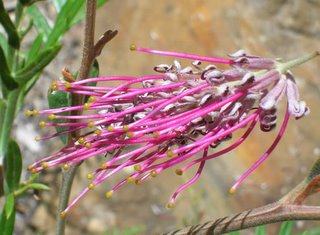 Time for a gratuitous plant picture. This one (didn't get the name) surprised me. Why? Because the colour (and appeal) isn't from the petals, as with most flowers, but because of the beautiful pink stamens, capped off with delicately yellow anthers. It's remarkable.
Time for a gratuitous plant picture. This one (didn't get the name) surprised me. Why? Because the colour (and appeal) isn't from the petals, as with most flowers, but because of the beautiful pink stamens, capped off with delicately yellow anthers. It's remarkable.As I write I'm sampling the Clonakilla 2004 Riesling and 2004 Shiraz Viognier. After a hard day of immunology, I think I deserve some refreshment. Both are very fine wines; the latter quite breathtaking.
As Warren Edwardes points out in a comment to an earlier post, the judges who award the Oscars must have been reading my blog, handing out best picture award to Crash. So I reckon it's time for some more of my rubbish movie reviews.
I watched four films courtesy of Singapore Airlines on Friday and Saturday nights, and my verdicts are as follows.
Harry Potter and the Goblet of Fire is one of those flicks where you come away saying 'weren't the special effects great'. Which means that the film itself was poor. I quite liked the first three Potter movies, but this was weak - a film without a plot; lacking any depth of story line or character development. It was predictable, and eventually rather dull. And the camera panned away too quickly when Pettigrew cut off his own hand. If you are going to rely on special effects to carry a film, then at least give us some gore.
What made me even think about watching Elizabethtown? But perhaps the bigger question is what could have made the men in suits think that it was a sensible idea to invest $$$$$ in such a limp, insipid, misguided production? There's a very flaky hollywood-shallow love story which then morphs into an inept, abbreviated road movie. I can only blame incipient jet-lag and car-crash-rubbernecking-tendencies for keeping me watching till the end. View at your peril.
The next film I watched was mildly entertaining pap about golf, The greatest game ever played. It was a Disney-made true life story about some young American guy no one had ever heard of winning the 1913 US Open, at a time when the Brits won all the tournaments. No shades of grey in this one: the Brits are snobby and arrogant; the Yanks are honest, straightforward, humble and underdoggish. And they give the Brits a bloody nose. Cue scenes of celebration and trophies held aloft.
Finally a film I can say something nice about. Walk the line, which chronicles the early career of Johnny Cash and his later mid-career struggles with addiction, alongside his yearnings for the already twice-married June Carter, is well written and brilliantly acted. You don't have to like country music (phew) to appreciate and enjoy this perfectly formed piece of cinema.
I've saved what I suspect will be the best of the 60-odd movies on demand for the long journey home.
Monday, March 06, 2006
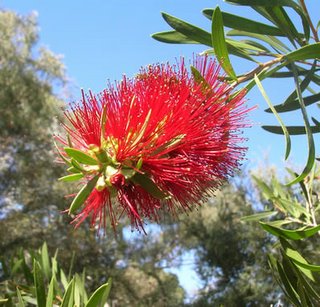 It's been a beautiful day in Canberra. With a free morning on my hands I wandered over to the botanic gardens and spent a pleasurable and refreshing couple of hours looking at plants. People assume that because I have a PhD in plant science that I can wander round woods and gardens happily reeling off long latin names. I can't. Of course, I know a little bit, but not as much as a keen gardener would: I looked at cells and bits inside them; I've never been a taxonomist.
It's been a beautiful day in Canberra. With a free morning on my hands I wandered over to the botanic gardens and spent a pleasurable and refreshing couple of hours looking at plants. People assume that because I have a PhD in plant science that I can wander round woods and gardens happily reeling off long latin names. I can't. Of course, I know a little bit, but not as much as a keen gardener would: I looked at cells and bits inside them; I've never been a taxonomist.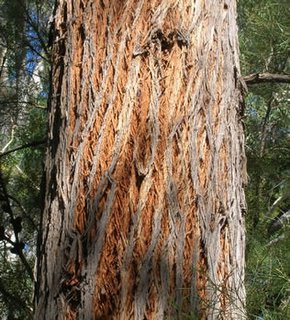 After this I wandered round town. Managed to find a couple of wine shops, and I bought a bottle of Clonakilla's 2004 Riesling, together with a cheap wine glass from Habitat so I can sit on the balcony of my room this evening, reading a book and drinking wine. I also bought a bottle of Cooper's Pale to go with lunch.
After this I wandered round town. Managed to find a couple of wine shops, and I bought a bottle of Clonakilla's 2004 Riesling, together with a cheap wine glass from Habitat so I can sit on the balcony of my room this evening, reading a book and drinking wine. I also bought a bottle of Cooper's Pale to go with lunch.The pictures show the wonderful red flower of Callistemon viminalis (above) and the intricate bark of Eucalyptus agglomerata.
Sunday, March 05, 2006
It's a beautiful morning in Canberra. As I write, it's just after 7am, and I've had my first proper sleep for three days. The early morning sunlight has illuminated the huge gum tree outside my window in the warm tones of first light, and there's the uniquely Australian chorus of birdsong ringing out to encourage me to get up and get involved in the day that's already begun.
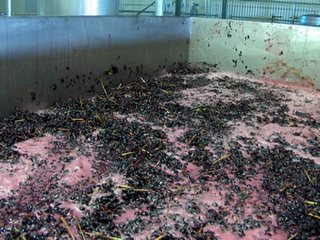 Yesterday afternoon was quite special. I visited Clonakilla, one of Australia's leading 'cult' wineries, but surprisingly relatively little talked about abroad. Tim Kirk generously swang round to pick me up at 1.30, with his five impeccably behaved children in the car. After dropping the kids off at Tim's home, we arrived at the winery and tasted the current releases, and then I got to see the 2006 Hilltops Shiraz which had just been picked a couple of days before (left). It was sitting in shallow two-ton fermenters (in Portugal these would be called lagares), and fermentation hadn't yet started. I had my first experience of pigeage, also known as cap plunging. This has to be done three times a day, and the idea is to prevent the cap of skins and partially crushed berries from drying out, as well as helping with the maceration - if these skins were left undisturbed they would form a dry, hard crust and there would be volatile acidity formed by the action of bacteria in the presence of air.
Yesterday afternoon was quite special. I visited Clonakilla, one of Australia's leading 'cult' wineries, but surprisingly relatively little talked about abroad. Tim Kirk generously swang round to pick me up at 1.30, with his five impeccably behaved children in the car. After dropping the kids off at Tim's home, we arrived at the winery and tasted the current releases, and then I got to see the 2006 Hilltops Shiraz which had just been picked a couple of days before (left). It was sitting in shallow two-ton fermenters (in Portugal these would be called lagares), and fermentation hadn't yet started. I had my first experience of pigeage, also known as cap plunging. This has to be done three times a day, and the idea is to prevent the cap of skins and partially crushed berries from drying out, as well as helping with the maceration - if these skins were left undisturbed they would form a dry, hard crust and there would be volatile acidity formed by the action of bacteria in the presence of air.There are a number of ways you can keep the cap wet. You could pump over juice, or you could use a special device to keep the cap submerged, or you can do it with feet, or a specially designed pole. Tim has a new hydraulic device that can be moved along the line of fermenters, but I tried doing it manually with the stainless steel pole device. I now know why he got the hydraulic cap plunger. The juice already had an intense purple colour, and tasted of fresh, sweet blackberry jam. After the pigeage, it was time to have a look at the sugar levels (potential alcohols ranged from 14.2 to 14.4%), before some barrel sampling of the 05s.
The Clonakilla wines are stunning. There are three whites, a fresh Semillon/Sauvignon that's fuity and correct, an ageworthy, tight Riesling and a remarkable, expressive Viognier (Australia's best?). Then there are the three red wines. The Cabernet Franc/Cabernet Sauvignon/Merlot blend (from 04 named 'Balinderry'; if the barrel samples are anything to go by, look out for the 05) is impressive and overlooked. The Hilltops Shiraz is from a warmer region an hour and a half's drive from the winery, and is remarkable value, offering intense, lush, pure fruit. The star of the show is the Shiraz Viognier: a breathtaking effort that has real elegance along with intensity and concentration. At Aus$65 (cellar door price) this isn't cheap, but it is fantastic value. 2004 is the current release, and the 2005 barrel samples were deeply impressive.
Saturday, March 04, 2006
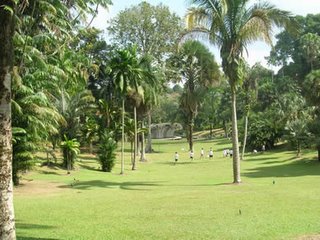 Had some fun in Singapore today, but I'm feeling a bit jetlagged. You just can't cheat your body clock and expect to get away scott free. After arriving bright and early I decided to nip over to the botanic gardens (right) before my noon lunch appointment. Getting off the MRT at Orchard, it was a good 15 minute walk to the garden gates, and by the time I got there I was overheating. It was worth the effort, though. Nature works for me. I wandered back, did a bit of shopping (some socks at last), and then caught the MRT to Chinatown where I met with my chums at the Majestic Restaurant (www.newmajestichotel.com). The food (modern Chinese) was fantastic. It was washed down with several wines, and lots of ice-cold water plus a bit of jasmine tea. We started off with a blind Champagne which I correctly (and rather luckily) guessed as a vintage 1996 Blanc de Blancs (it was from Duval Leroy, very nice, too) and this was followed up with an Ostertag Riesling and a Porto Carras Malagouzia 2004 (Greece). For reds there were two 1999s: Allemand Cornas Chaillot and Hermitage Cave de Tain. We had four different shared desserts, including one based on the pungent smelling Durian fruit. I enjoyed it, but I can still taste it now, some two hours later. Singapore is fun, and while I'm sure I'll pay the price for my short excursion here in terms of jetlag, it has been worth it.
Had some fun in Singapore today, but I'm feeling a bit jetlagged. You just can't cheat your body clock and expect to get away scott free. After arriving bright and early I decided to nip over to the botanic gardens (right) before my noon lunch appointment. Getting off the MRT at Orchard, it was a good 15 minute walk to the garden gates, and by the time I got there I was overheating. It was worth the effort, though. Nature works for me. I wandered back, did a bit of shopping (some socks at last), and then caught the MRT to Chinatown where I met with my chums at the Majestic Restaurant (www.newmajestichotel.com). The food (modern Chinese) was fantastic. It was washed down with several wines, and lots of ice-cold water plus a bit of jasmine tea. We started off with a blind Champagne which I correctly (and rather luckily) guessed as a vintage 1996 Blanc de Blancs (it was from Duval Leroy, very nice, too) and this was followed up with an Ostertag Riesling and a Porto Carras Malagouzia 2004 (Greece). For reds there were two 1999s: Allemand Cornas Chaillot and Hermitage Cave de Tain. We had four different shared desserts, including one based on the pungent smelling Durian fruit. I enjoyed it, but I can still taste it now, some two hours later. Singapore is fun, and while I'm sure I'll pay the price for my short excursion here in terms of jetlag, it has been worth it.
Friday, March 03, 2006
I'm online at 30 000 ft somewhere between London and Singapore. And for free. How cool is that? I only get 30 minutes though, and it's surprising how quickly that goes online. I'm due into Singapore at 7 am, and I have lunch booked with some of my wine nut friends there, including the Man City-supporting Hsien Min. In the evening I'm back on the plane, and after nipping over from Melbourne to Singapore I'm going to be spending Sunday afternoon at Clonakilla. Then it's a few days of science before nipping back to Melbourne for the Yarra Valley. I'm looking forward to it.
Heathrow Terminal 3 sucks. I keep forgetting how crowded it is and how hideous the shops are past security: expensive 'label' shops mostly. There was only one bookshop, and it had a small range. The only interesting retail outlet here is a small Berry Bros & Rudd, which has a small but nicely chosen selection there. I wanted to buy some socks, because I've run out after recently chucking out all the ones with holes. It's a long time since I did this and so I was left with one pair of dark socks. Terminal 3 doesn't have anywhere you can buy socks, as far as I could tell.
Wednesday, March 01, 2006
Today I almost got to interview Jose Mourinho, the special one. When I say 'almost', what I mean is that the media company running the new cork campaign, of which he is the figurehead, gave me a slot of 10 minutes from 15.50 with him. There was, however, a warning that they couldn't guarantee he'd show up at the Portuguese embassy, where the launch was taking place. He didn't come. Cynics would conclude that the possibility of an interview was dangled as a carrot to get leading journalists to attend what otherwise might be seen as a less than compelling invite, even though there was no real potential for a showing by Jose. He is one busy, sought-after dude, one of the most famous people in the UK, and a household name wherever football is played.
Still, I did get an extensive interview with Antonio Amorim, which will be useful for my forthcoming closures book. Did you know that the annual market worldwide for wine bottle closures is some 18 billion, of which cork's share is 14 billion? 10 years ago the market was 14 billion, almost all cork. So cork has lost market share, but not market. The next five years will be very interesting for closures. Stop yawning: this is a serious wine quality issue!
On a football theme, I watched England's friendly game against Uruguay. Watching friendlies is usually a bad idea, as these matches are frequently as interesting as a £4 Australian Chardonnay. Some observations. Joe Cole was brilliant out wide left. He's made this position his. Beckham was ineffectual on the right and Shaun Wright-Phillips' display in the last 20 minutes argues for the unthinkable: he should be playing in place of Beckham. Carrick deserves a place on tonight's showing in the holding midfield role. Wild thought: play him there, with Gerrard and Lampard freed to play a more attacking role. You'd have to drop a striker, though - could it work with just Rooney up front? Could England adopt a more fluid sort of formation where the traditional boundaries of midfield and attack have broken down? Is 4-4-2 dead?
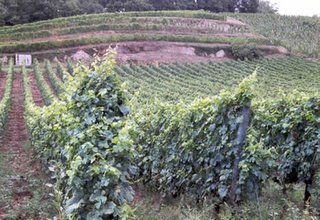 Two Crozes-Hermitage to report on (vineyards pictured). The 2004 from Caves des Tain as supplied to UK supermarket M&S isn't as good as the 2003, which was a cracker. It lacks the Northern Rhone distinctiveness that made the 2003 so good. Pleasant but no more; a shame. Gilles Robin Cuvee Alberic Bouvard Crozes Hermitage 2003 (£12.95 Western Wines) is a lot better with nice meaty, spicy dark fruits. Quite savoury and intense, with firm tannins. Not top rank, but a very nice drink. Crozes-Hermitage is a good place to start if you are exploring the northern Rhone on any sort of restricted budget.
Two Crozes-Hermitage to report on (vineyards pictured). The 2004 from Caves des Tain as supplied to UK supermarket M&S isn't as good as the 2003, which was a cracker. It lacks the Northern Rhone distinctiveness that made the 2003 so good. Pleasant but no more; a shame. Gilles Robin Cuvee Alberic Bouvard Crozes Hermitage 2003 (£12.95 Western Wines) is a lot better with nice meaty, spicy dark fruits. Quite savoury and intense, with firm tannins. Not top rank, but a very nice drink. Crozes-Hermitage is a good place to start if you are exploring the northern Rhone on any sort of restricted budget.
 The web log of wine journalist Jamie Goode. Feel free to nose around; your comments are welcome
The web log of wine journalist Jamie Goode. Feel free to nose around; your comments are welcome 
